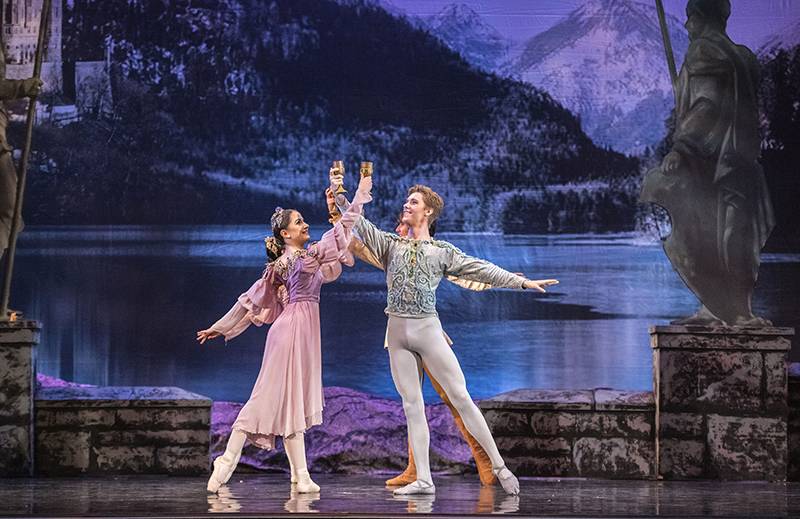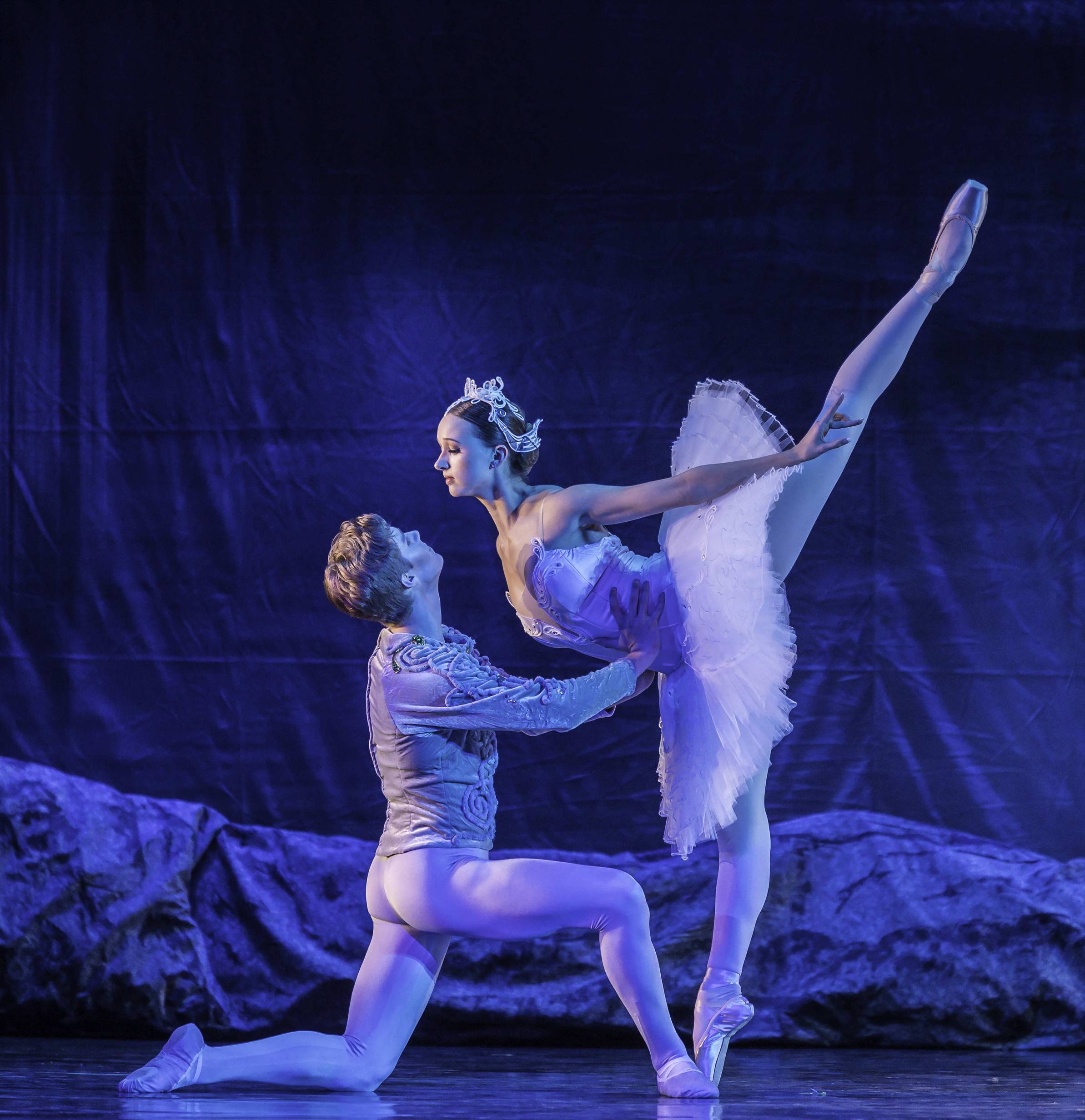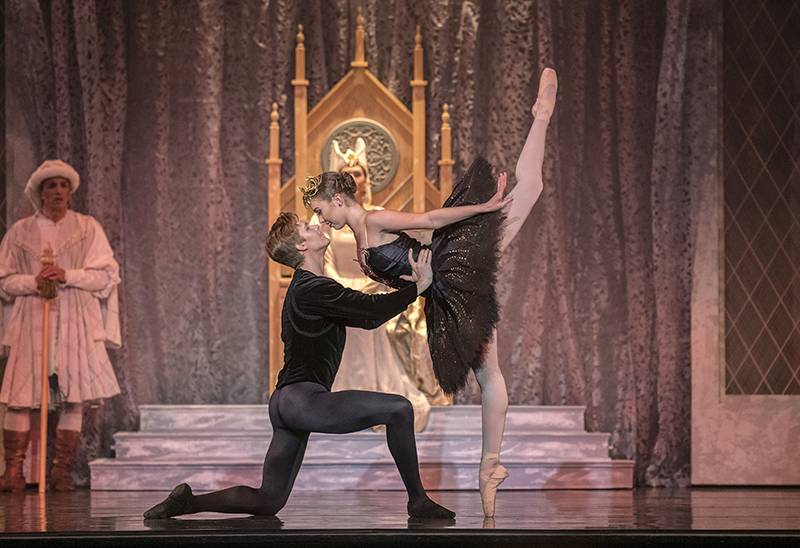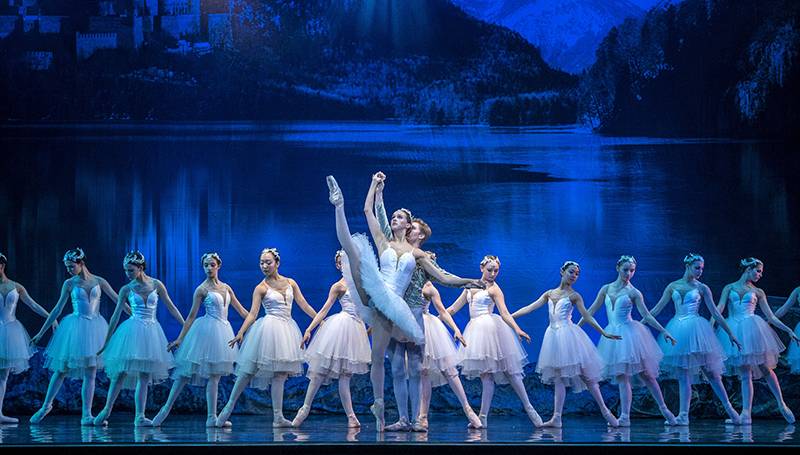The arrival of CU Ballet’s Swan Lake is in many ways like the arrival of the Olympics. Both audience and dancers have waited for years. Hundreds of hours of painful preparation, sacrifice, and commitment to a shared vision of excellence have led up to this moment. Expectations and emotions run high. Now imagine all of the gold medalists from each of the events—everyone from lighting designer to soloist—sharing the stage at once. This is opening night of CU Ballet’s Swan Lake.
Swan Lake is both a display of Olympic-style athleticism and Olympian-sized emotions. CU Ballet chose the tagline “A Passionate Tale of Fated Love,” and yes, the Odette/Siegfried/Odile love triangle (and its tragic outcome) is the ballet’s central trope. Yet, under Deanna Doty’s direction, this production of Swan Lake, uncovers deeper themes of youth vs. age, tradition vs. individual freedom, and innocence vs. experience.
Act I opens with a deceptively idyllic display of young maidens dancing and young men raising glasses with cheer. This is no mere welcoming of spring, this is, as the program tells us, “The Christening” — an annointment, a marking of faith, commitment and new beginnings.

Alfred, Lord Tennyson famously wrote that “in the spring a young man’s fancy lightly turns to thoughts of love.” Yet for Prince Siegfried, the promise of love takes a darker turn.
As we are charmed by the charismatic performances of CU’s Ballet’s younger dancers (shout out to the adorable and energetic young fiddlers), the celebration takes a more serious tone with the arrival of the Queen. Played to perfection by Ainsley McDaniel, the Queen relies on gesture rather than dance to tell her story.
A single movement of the Queen’s hand brings about one of the night’s funniest moments as her young male servants emerge with a series of painted and framed portraits of potential wives in an OG version of Match.com. As Siegfried resists her call to put away childish things and get on with the serious business of becoming a king, he is answered repeatedly by a simple, yet powerful raise of the Queen’s palm. No means no.
Despite his apparent pleasure while raising a glass or dancing with one of the pretty young things gathered to celebrate his coming of age, Siegfried is inherently a melancholy prince. Before there is even an Odette to be lost, he struggles under the weight of looming responsibilities in a world that offers him very little free will.
This is his first loss — the loss of youth and freedom, as he struggles to hold onto a life of revelry, comradery and the potential for love. As the crossbows are ceremoniously distributed, boys become men— and soldiers.
Dance as a form of communication, resembles with poetry in its economy and precision. Audiences can glean meaning from set, costume, lighting, and, of course, music, but without the narrative guidance of dialogue and exposition, both performers and audiences must work a bit harder and go a bit deepr in this shared experience of meaning-making.
With Swan Lake in particular, where source material is drawn from centuries of folklore and myth, and those of us who see the world not in terms of black or white swans but in complex ranges of grey, we must forgive the storytelling its sins of economy and omission, as they are necessary evils of the art form,
That said, this puzzle-loving wordsmith discovered a few deeply-packed Easter eggs upon rereading the program. After being haunted by the naming of Act I as the “The Christening,” I couldn’t shake the feeling that there was something here I was missing. And there was. The very names themselves. A quick Google search informed me that the name Siegfried translates to “victorious peace,” while Odette is defined as (or in the case, defined by) the sea. Odile, as Von Rothbart must have clearly known, means wealth and fortune. Make of this what you will.
The story of Siegfried and Odette’s love begins with pure happenstance and continues with highs and lows worthy of Olympic divers. It requires so very much of those who dance it. Each gesture, every single movement must carry the story forward, deepen our understanding of and empathy for the characters, and inform inquiries into theme and interpretation. All this en pointe while executing some of the most demanding choreography in history. Ashlynn Brown’s achingly beautiful portrayal of Odette’s duality, and the pain of her torn identity, manifested in each movement struggling between human and swan form.
Siegfried, danced by Elijah Ochs, performs with an elegance and emotional range worthy of Nureyev. Siegfried is a demanding role and Ochs dances the hell out of it. From the gravity defying leaps of his solos to the subtlest hand positions while walking or standing, Ochs draws us in deep. In his partnerings with Brown’s Odette, his movement follow hers—she inhales, initiates the lift herself and he follows with gentle, yet steady support, acknowledging her strength and agency.

Brown’s Odette is beautifully supported by her corps of swans. Echoing the struggle of exisitng in two worlds, two bodies, the swans provide an exquisite illustration of community and the power of sisterhood.
Lauren Frost is perfectly cast at Odile, the black swan. Her knowing smile, the mischevious glint in her eyes. Her capacity for communicating seductiveness with the slightest gesture first won me over in her portrayal of Mrs. Stahlbaum in the CU Ballet’s 2018 production of The Nutcracker. She is well-paired with both Ochs’ love-stricken Siegfried and Rob Rypka’s magical, menacing Von Rothbart.

Like McDaniel, Rypka carries much of the story’s narrative and emotional weight in the bewitching gestures of his hands. Perhaps even more so in his human form than as the dark winged creature we meet at the lake, Rypka’s darkly elegant Von Rothbart spins the tale, or rather pulls both the narrative and heart strings.
Yet it is the wizardry of the production team that brings us one of Swan Lake’s most stunningly, gasp-worthy moments – Siegfried’s realization that the women he has sworn his loyalty to is not in fact Odette. In a flash of light, the ballroom window is illuminated and we see a desperate Odette outside. Here light serves as a cruel awakening to a dark truth.
Doty chooses to take us back to the lake, where in the final battle of a now reconciled Odette and Siegfried must fight Von Rothbart for their very lives. Odette, the selfless heroine, throws herself over the cliff to end the curse, and Von Rothbart’s power over her, hoping this will save Siegfried’s life. Perhaps she realizes that Von Rothbart needs Siegfried alive in order to secure his own rise to power. When Siegfried follows Odette over the cliff, he does so out of grief, not wanting to live in a world without her. Whether inspired by impulse or premeditation, Siegfried’s leap sends ripples throughout the lives of those remaining.
And as the program tells us, “Von Rothbart is destroyed by the lover’s fatal commitment. Dawn breaks and the impossible love of the Prince and the Swan Queen is immortalized in the memory of the lake. Von Rothbart is destroyed by the lover’s fatal commitment. Dawn breaks and the impossible love of the Prince and the Swan Queen is immortalized in the memory of the lake.” This movement from darkness and danger to victorious immortal love is ingeniusly manifested by set designer Andy Warfel’s Mood ring-like backdrop, which serves the meaning-making from beginning to end.
In the end there is no winner, The Queen Mother is left without an heir. Her attempt to maintain the old ways and the requirement to to sacrifice individual desire for duty to family and country are thwarted. Von Rothbart’s carefully planned power grab fails. The Queen Mother and Von Rothbart both emerge as puppeteers whose most precisely timed movements are undone first by fate, and then by sacrifice.
While endings of Swan Lake have been known to vary, Doty’s production chooses a bittersweet Romantic (emphasis on the “R”) ending that celebrates personal impulse and its victory over rationalism. Taken this way there is almost something punk rock about their lovers leap. They created their own ending, binding themselves to each other forever, despite all the powers that worked to keep them apart. The melancholy prince finds his tragic form of victorious peace alongside the sea.
While those of us who have been spoiled by the opportunity to experience CU Ballet’s production of The Nutcracker performed to the live music of the Champaign Symphony Orchestra, the energy of the live musicians is missed. But the magic of the CU Ballet’s charismatic and highly-skilled dancers, supported by the creativity of its production team, brought home the gold.
CU Ballet’s Swan Lake
The Virginia Theatre
May 3rd and 4th, 2019
203 W Park Ave., Champaign
Photos by Darrell Hoemann








